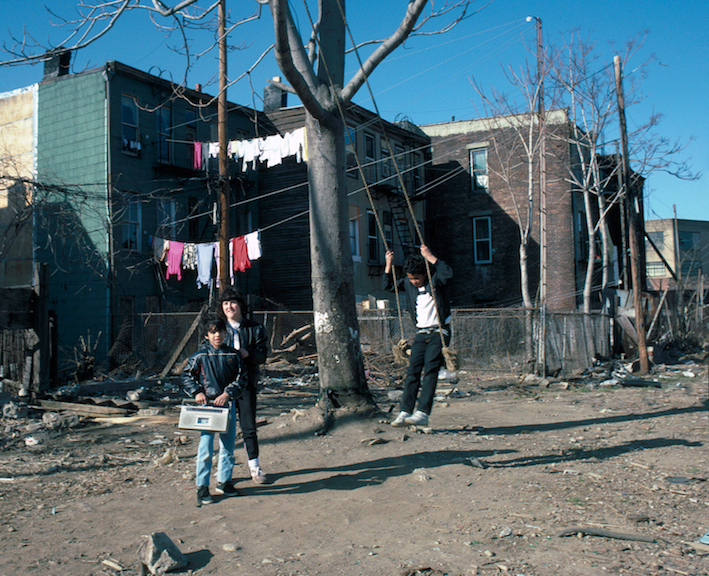A heartwarming portrait of pre-gentrification Bushwick
- Text by Miss Rosen
- Photography by Meryl Meisler

When American photographer Meryl Meisler arrived in Bushwick, Brooklyn, for a job interview at I.S. 291 Roland Hayes in December 1981, she was shocked at the state of the neighbourhood.
“I got out of the subway and everything was boarded up or burned down. It looked like there was a war going on but this was a quiet time,” she recalls. “I thought to myself, ‘It’s a week before Christmas and there’s a job opening? Maybe the other art teacher was killed.’”
Meisler, who had previously been a hostess in Manhattan’s famous go-go bars, arrived at the junior high school on Palmetto Street. The school stood at the edge of an area that had been destroyed by a devastating fire that wiped out 23 buildings that occurred just one week after the infamous 1977 blackout unleashed a wave of arson and looting across the community.

Palmetto St., Bushwick, Brooklyn, NY, 1982
Four years later, Bushwick remained in dire straits, with 45 per cent of the population living below the poverty level. “I later found out it had one of the highest vacancy rates in the city – people were leaving,” says Meisler.
Upon arriving at I.S. 291, Meisler was enveloped in a sea of frenetic energy typical of middle schools and she met with the principal. “He was dressed in a three-piece suit – very refined, despite the sense of chaos in the air,” she remembers. Meisler took the job.
“I didn’t carry a camera at first because of the danger. While teaching on the Lower East Side, I was robbed in school – so I wasn’t going to be an idiot twice,” she says.

The School Yard Fence Face to Face, Palmetto St., Bushwick, May 1983
But her love of photography triumphed and Meisler began capturing everyday scenes in school and around the community. Forty years later, a selection of the images from Meisler’s first three books is now on view in Paradise Lost & Found: Bushwick, which has been installed on the chainlink fence outside I.S. 291.
“I’ve always wanted to show this work in Bushwick,” says Meisler, who teamed up with current Principal Janice E. Bruce to co-curate the exhibition. “Ms. Bruce is probably the same age as the kids in the photographs. She’s a success story – she went to Cornell University, came back, taught in other schools in the neighbourhood, then became the principal here.”

Beauty Salon, Bushwick, circa 1984
As an insider, Bruce’s experience gave her the necessary insight to co-curate the exhibition to ensure it would resonate for students and members of the community alike. After the exhibition went up, Meisler ran over in the morning to see it for herself. “A lot of people still lived on the block, went to the school, or to the church across the street are still in the neighbourhood. The current custodian at I.S. 291 recognised his niece and nephew in one of the pictures!”
Someone asked if I was the photographer because I was wearing a camera around my neck. I said, ‘Yes,’ and they told me, ‘This is so uplifting!’”

Bus Study, Bushwick, September 1983

Sneakers, I.S. 291, Bushwick, Brooklyn, 1984

Boom Box, Swing, and Laundry, Bushwick, Brooklyn, NY. March 1983

Bushwick, Brooklyn, NY circa 1984
Meryl Meisler: Paradise Lost & Found: Bushwick is on view at Photoville, Brooklyn, through December 2021. Signed copies of Meryl’s latest book New York PARADISE LOST Bushwick Era Disco are now available.
Follow Miss Rosen on Twitter.
Enjoyed this article? Like Huck on Facebook or follow us on Twitter.
You might like

On a night out with the cast of Skins, Ewen Spencer captured millennial hedonism in all its unabated, messy glory
One Night in Watford — Commissioned to take promotional pictures for the generation-defining teen drama before it hit screens, the legendary youth culture photographer revisits the fun-fuelled evening, which was equal parts work and play, in his new photobook.
Written by: Isaac Muk

Largest-Ever Display of UK AIDS Memorial Quilt Opens at Tate Modern
Grief Made Visible — Comprising hundreds of panels made by lovers, friends and chosen family, the UK AIDS Memorial Quilt returns in full for the first time since 1994 – a testament to grief, friendship and the ongoing fight against HIV stigma.
Written by: Ella Glossop

The carnival and community of New York’s block parties
Soul of the Summer — Since attending his first street party in Crown Heights two decades ago, photographer Anderson Zaca has spent his summers travelling across New York’s five boroughs, documenting over 300 in the process.
Written by: Miss Rosen

The Getty Center’s first exclusively queer exhibition opens today
$3 Bill: Evidence of Queer Lives — Running until September, it features paintings, ephemera, video and photography to highlight LGBTQ+ histories, culture and people from 1900 to the present day.
Written by: Isaac Muk

Remembering New York’s ’90s gay scene via its vibrant nightclub flyers
Getting In — After coming out in his 20s, David Kennerley became a fixture on the city’s queer scene, while pocketing invites that he picked up along the way. His latest book dives into his rich archive.
Written by: Miss Rosen

On Alexander Skarsgård’s trousers, The Rehearsal, and the importance of weirdos
Freaks and Finances — In the May edition of our monthly culture newsletter, columnist Emma Garland reflects on the Swedish actor’s Cannes look, Nathan Fielder’s wild ambition, and Jafaican.
Written by: Emma Garland

